380 volt 3 phase private home circuit. Three phases in a private house: connection, circuit and purpose
So, why does a voltage of 380 V come to some switchboards, and 220 to some? Why do some consumers have a three-phase voltage, while others have a single-phase voltage?
There was a time, I asked these questions and looked for answers to them. Now I’ll tell you in a popular way, without the formulas and diagrams with which textbooks abound.
In other words. If one phase approaches the consumer, then the consumer is called single-phase, and its supply voltage will be 220 V (phase). If we talk about three-phase voltage, then we are always talking about a voltage of 380 V (linear).
How are three phases different from one?
In both types of power supply there is a working neutral conductor (ZERO). About protective grounding I, this is an extensive topic. In relation to zero in all three phases - a voltage of 220 volts. But in relation to these three phases to each other - they have 380 volts.
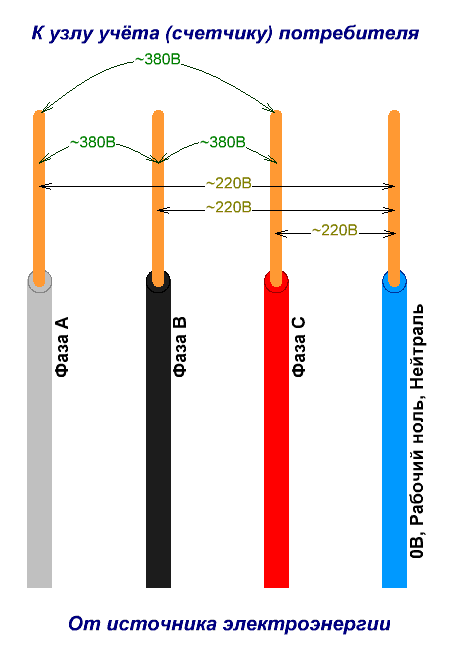
Voltages in a three-phase system
This happens because the voltages (under active load, and current) on the three phase wires differ by a third of the cycle, i.e. 120 °.
More details can be found in the electrical engineering textbook - about voltage and current in a three-phase network, as well as see vector diagrams.
It turns out that if we have a three-phase voltage, then we have three phase voltages of 220 V. And single-phase consumers (and such - almost 100% in our homes) can be connected to any phase and zero. Only this must be done so that the consumption for each phase is approximately the same, otherwise a phase imbalance is possible.
In addition, an excessively loaded phase will be difficult and insulting that others are "resting")
Advantages and disadvantages
Both power systems have their pros and cons, which change places or become insignificant when the power goes over a threshold of 10 kW. I will try to list.
Single-phase network 220 V, pluses
- Simplicity
- Cheapness
- Lower hazardous voltage
Single-phase 220 V network, cons
- Limited consumer power
Three-phase network 380 V, pluses
- Power is limited only by the cross-section of the wires
- Saving with three-phase consumption
- Industrial equipment power
- The ability to switch a single-phase load to a “good” phase in case of quality deterioration or power failure
Three-phase network 380 V, minuses
- More expensive equipment
- More dangerous voltage
When is 380, and when is 220?
So why in our apartments we have a voltage of 220 V, and not 380? The fact is that consumers, with a capacity of less than 10 kW, as a rule, connect one phase. And this means that one phase is introduced into the house and a neutral (zero) conductor. In 99% of apartments and houses, this is exactly what happens.
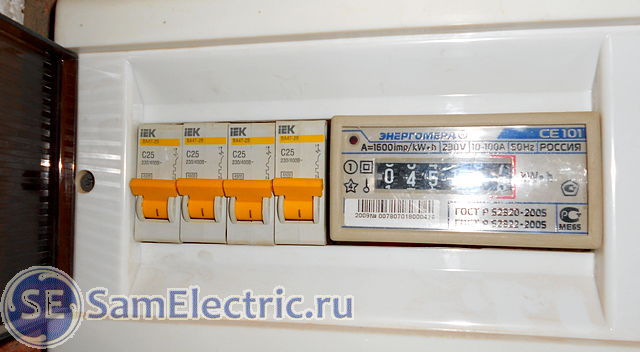
Single-phase switchboard in the house. The right machine is introductory, then - by room. Who will find errors in the photo? Although, this shield is one big mistake ...
However, if it is planned to consume power of more than 10 kW, it is better to use a three-phase input. And if there is equipment with three-phase power supply (containing), then I categorically recommend starting a three-phase input with a linear voltage of 380 V. in the house. This will save on wire cross-section, on safety, and on electricity.
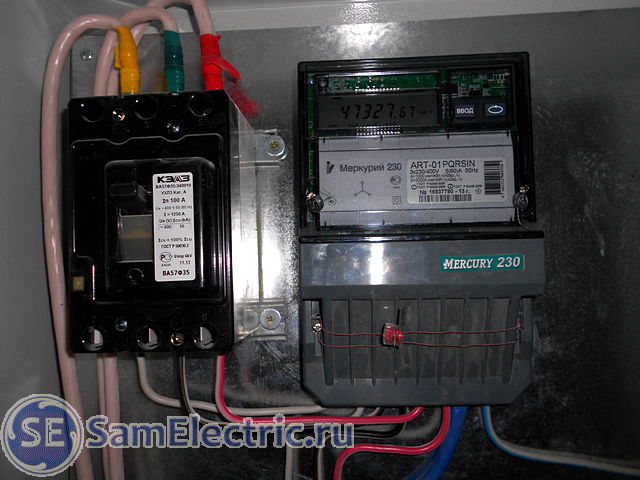
Despite the fact that there are ways to include a three-phase load in single phase network, such alterations sharply reduce the efficiency of engines, and sometimes, ceteris paribus, you can pay 2 times more for 220 V than for 380.
Single-phase voltage is used in the private sector, where the power consumption, as a rule, does not exceed 10 kW. At the same time, a cable with wires with a cross section of 4-6 mm² is used at the input. The current consumption is limited by an input circuit breaker, the rated protection current of which is not more than 40 A.
About the choice of a circuit breaker, I already. And about the choice of wire section -. There are also heated discussions of issues.
But if the consumer's power is 15 kW and above, then there is a need to use three-phase power. Even if in this building there are no three-phase consumers, for example, electric motors. In this case, the power is divided into phases, and the electrical equipment (input cable, switching) does not bear the same load as if the same power was taken from one phase.

For example, 15 kW is about 70 A for one phase, a copper wire with a cross section of at least 10 mm² is needed. A cable with such conductors will cost significantly. And I did not see any machines for one phase (single-pole) with a current of more than 63 A on a DIN rail.
Therefore, in offices, shops, and even more so in enterprises, only three-phase power is used. And, accordingly, three-phase meters, which are direct connection and transformer inclusion (with current transformers).
And at the input (in front of the counter) there are approximately such “boxes”:
Maybe it will be interesting:
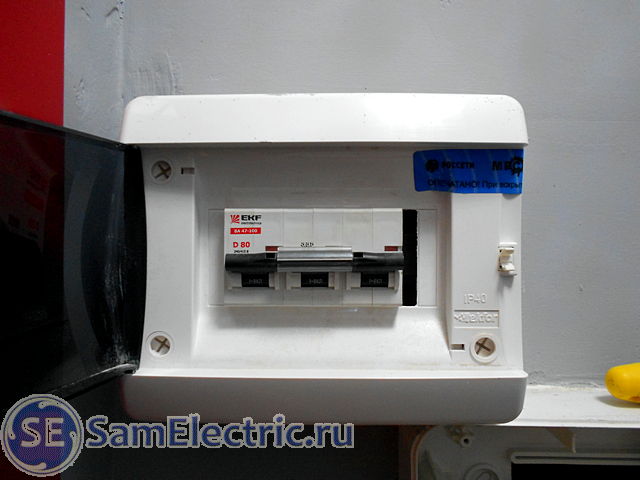
Three-phase input. Introductory machine in front of the counter.
I hope now it’s clear what is a three-phase voltage of 380 V and a single-phase voltage of 220 V?
Three-phase Star and Triangle Circuits
There are various variations of switching on the load with an operating voltage of 220 and 380 volts in three phase network. These patterns are called “Star” and “Triangle”.
When the load is rated for 220V, then it is included in the three-phase network according to the "Star" scheme, i.e. to phase voltage. Moreover, all load groups are distributed so that the power in phases is approximately the same. Zeros of all groups are connected together and connected to a neutral wire of a three-phase input.
All our apartments and houses with single-phase input are connected to the Star, another example is the connection of heating elements in powerful and.
When the load on the voltage is 380V, then it is turned on according to the "Triangle" circuit, that is, to the linear voltage. Such a phase distribution is most typical of electric motors and other loads, where all three parts of the load belong to a single device.
Power distribution system
Initially, the voltage is always three-phase. By "source" I mean a generator in a power plant (thermal, gas, nuclear), from which a voltage of many thousands of volts is supplied to step-down transformers, which form several voltage steps. The last transformer lowers the voltage to the level of 0.4 kV and delivers it to the end consumers - to you and me, in apartment buildings and in the private residential sector.
Large enterprises with power consumption of more than 100 kW usually have their own substations 10 / 0.4 kV.
Clearly:
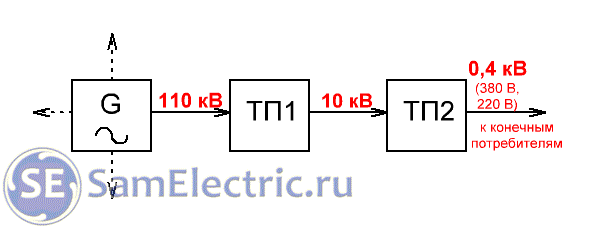
Three-phase power supply - steps from generator to consumer
The figure simplistically shows how the voltage from generator G (everywhere we are talking about three-phase) 110 kV (maybe 220 kV, 330 kV or another) is supplied to the first transformer substation TP1, which lowers the voltage for the first time to 10 kV. One such TP is installed to power a city or district and can have a power of the order of units to hundreds of megawatts (MW).
Further, the voltage is supplied to the transformer TP2 of the second stage, the output of which is the end-user voltage of 0.4 kV (380V). Power transformers TP2 - from hundreds to thousands of kW. With TP2, voltage comes to us - to several apartment buildings, to the private sector, etc.
The scheme is simplified, there can be several steps, voltages and power can be different, but the essence does not change from this. Only the final voltage of consumers is one - 380 V.
A photo
Finally - a few more photos with comments.
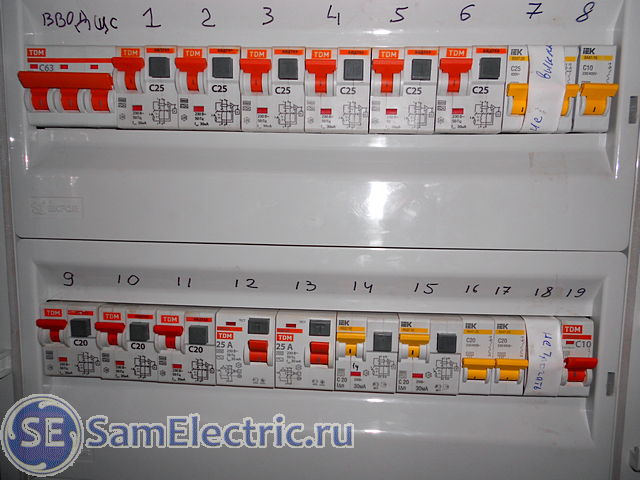
Electrical switchboard with three-phase input, but all consumers are single-phase.
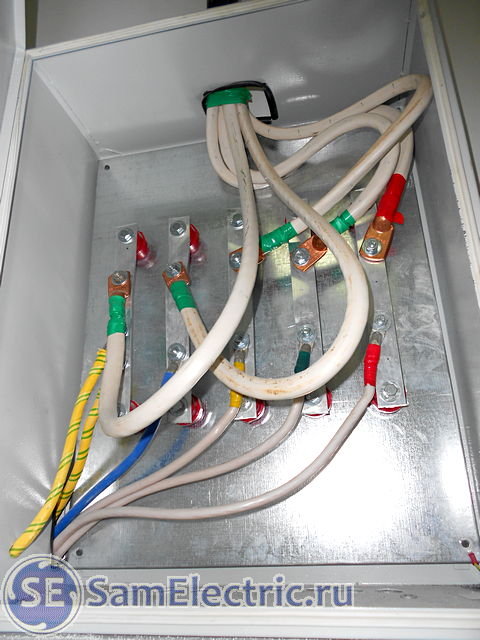
Friends, that's all for today, good luck to everyone!
Waiting for feedback and questions in the comments!
People often ask me: “Why did you bring a three-phase line to your house, do you have any special power tool?” No, the instrument is the most common at 220 volts, however, the power sometimes reaches two kilowatts. Well indeed why do i need three phases in the house? How to connect them without errors?
Theory and practice of connection
First, quite a bit of general information. Optionally, the supply line can be single-phase when there are only two wires, or three-phase when four wires, three phase wires and one zero wire. So are the generators that generate electricity that they have only three coils. Therefore, if you specify a power of up to 5 kW in technical specifications, you are powered from one coil, ask for more, then immediately from three coils.
How to spend three phases in a private house? If there is a technical possibility, it is required to request (declare) about such a connection. True, on the way from the generator to you there will be a transformer that reduces the high-voltage voltage to a household value, so you will not get 380, but your own 220. But you will have three phases of 220 volts! In the latter case, from the shield with circuit breakers in the house, three network lines will go immediately, each having a voltage of 220 volts and power from 3.5 to 5 kW, depending on the installed machine.
The connection and wiring diagrams taking into account the presence of three phases can be different, depending on the needs and the availability of buildings on the site, but the general principles are, of course, the same. Next is my personal option:
Connection diagram for three phases of a private house and farm buildings on the site
By the way, circuit breakers (fuses) are also necessary in the bathhouse and in the hozblok. Installed at the same current as with the central input, they in these buildings will work faster if the load is faulty, due to losses in the supply line.
This winter I already felt three phase leadwhen the dog Bob, having played enough on the first snow, wrapped up in a blanket was warming himself at the oil cooler in the change house, additionally directing his muzzle to the heated air coming from the fan heater. It was possible not to be afraid that the fuse would trip due to overload when working with a power tool of high power by connecting to a temporary outlet with a different phase.
Why do I need a temporary outlet?
Well, of course, not because of the dog. When there are already walls and windows, there is a roof over your head and a black floor is laid, but there is not enough interior decoration, then it is time for a temporary outlet inside the house. And it’s extremely inconvenient to drag an extension cord from a change house every time. Although the outlet is called temporary, it must be done like a real one, according to all safety rules using a circuit breaker.
Determine the phase correctly: color and numbering
Honestly, I didn’t really think about the phases when I used to do wiring in my country house. My father also did not pay attention to this, in those days all the wiring was almost the same, in cracked rubber insulation. However, when I decided to tackle the electrification of the economy and assemble a shield for three phases, I voluntarily learned quite a few facts about the history of electricity in our country.
What color is the phase?
The fact is, in the Soviet Union, phase wires were yellow, red or green colors. After the disappearance of the Union from the world map, the colors changed to brown, black and gray. However, this fact is absolutely not connected with the colors with the symbolism of flags. The fact is that with regard to wire marking, European standards have been adopted. The last color scheme listed is distinguishable for people with visual impairments. But what united us with Europe for quite some time is that our land and neutral have always been the same color, - yellow green earth and blue (light blue) neutral.
Remembering the last thing neutral wire blue or blue (light blue) and ground green with a yellow stripe, logically understand that the phase will be any other remaining color, confidently connect the wires for the next generations, regardless of future revolutions and shocks of the world. This is the answer to the question of how to connect the three phases.
But in other countries, wire marking is different. As you think about it, it immediately appears to go into the armored car and shout loudly: “Electricians of all camps - unite!”
Why number the three phases?
For a single-phase circuit, where one phase, it makes no sense. But for a three-phase transmission line, we number, so to speak, for the future according to the sequence of colors of the cable leading to the house. Having pressed yourself to the six-meter staircase and connecting the nuts coming out of the hole in the wall of the house with nuts to the air duct, do not forget to shout:
“The first phase is the brown wire! The second phase is the black wire! The third phase is the gray wire! ”
In the same sequence, you must connect the wires to the built-in circuit breaker. A fat marker for numbering will not interfere.
Near the electrical panel, it is necessary to hang a picture in a frame with a complete electrical circuit, with the numbering of each circuit breaker, and the color scheme of the wires. I think that an evacuation plan is not required in this case.
Yes, I did not answer the question of why numbering is needed. I don’t know yet. Suddenly, the son will buy an electric device exclusively for a three-phase circuit with instructions where the phases are indicated by numbers? Then you don’t have to climb the seven-meter ladder again, having completely forgotten by that time both colors and numbers.
How to connect the wires in the junction boxes?
The question is really important. Contacts are the most vulnerable spot in any electrical circuit. And today the issue is resolved how to NOT connect.
We discard all threaded connections. Anyone who drove domestic cars, and every year stretched a thread, will not argue with me. Under the influence of different temperatures, the bolt and nut will change their linear dimensions, and the connection will weaken, plus an even poor coating, and as a result - rust. The end of the contact will come quickly. Many still remember the warmed up and molten plugs and sockets.
From the last century, there is still a twist followed by soldering. And in the new century, contacts with springs, for example from WAGO, are still in the first place. Installation of wiring in this case may resemble a game in the LEGO constructor. But remember that the stranded wire for contact will still have to be twisted and soldered. If I’m invited to a barbecue, and while he’s preparing, they will ask me to help with the wiring, then I’ll pre-fill all the pockets with spring terminals, so that they can be quickly released, otherwise the meat will be eaten without me. But I’ll still do a twist for myself.
Why do we need light and power sockets from different circuit breakers (fuses)?
Here are a few answers. To whom you like ... To choose:
- It is easier to find a malfunction when it is closed in the chandelier if it works on the world, or the electric kettle comes to an end if it works on outlets.
- In terms of lighting, power consumption is less, especially when using energy-saving lamps, therefore, the automatic device will stand at a lower current and it will work faster without having to overheat the wires. This condition allows the use of lighting wires with a smaller cross section (0.75 mm), again, savings. Yes, and it will be a shame when the time on the computer goes to empty after closing the light bulb in the chandelier, in the case of a common fuse.
- You won’t have to search for candles; we won’t stay in complete darkness.
Is there a need for a residual current device (RCD)?
Yes there is, we will put an RCD and do grounding, without the latter the first does not work. Euro sockets with ground lamellas. There is a child and a dog. Safety should come first. Now we are discussing the question of putting a common RCD on everything, or just on the bathroom. There is still time: tea has not completely cooled :)
P.S. Three phases in a private house really worthwhile thing, allowing you to feel more confident and calm. Indulge in added convenience ...
To make a three-phase connection correctly country house Follow these guidelines. First of all, you should know why you should choose this particular way of providing electricity to your home. To date, this method is the most common because of the interests of economy.
With a three-phase connection to the country house, three line wires complete with one zero wire or, as it is also called neutral, will be connected at once. 
The latter, performs a special function. It simultaneously acts as a protective and working conductor. There are times when administered immediately 2 neutral wires. In this case, one of them will act as a protective one, and the second, therefore, as a worker. They are usually painted in different colors to make them easier to distinguish.
The principle of operation of a three-phase connection is quite simple. In most cases, from a neutral point, which is located in the transformer and there is a supply of neutral supply to all sections.
It should be grounded tightly. Please note that the potential of this supply must fully correspond to the potential of the suburban area. That is why this drive is called zero.
As for the other drives, they have a special voltage, which creates the necessary voltage.
To make it easier for you to understand what is at stake, it should be noted that voltage means the difference that arises between two potentials. By standard standards, it is approximately 380 V.
As for the voltage between the neutral and linear wires, it will be slightly less and will be about 220 V.
Even if the neutral wire is earthed, the voltage between it and the linear analog will remain within 220 V. 
You must remember such nuances without fail. a similar voltage can be observed between the live part and the ground.
Despite the fact that we are considering a three-phase connection, it is impossible not to mention the single-phase method. This method is much easier to implement.
To do this, you just need to bring one wire of a linear type to the house and do not forget about the supply of one linear.
With this connection, the distance from the wire to the object should be observed. It should be about 3 m. To ground, you will need a grounding type bolt.
Its diameter should be 8 mm. For proper grounding, we recommend using a piece of bare wire. Follow all our simple recommendations and the connection of the country house will be successful.
We also recommend taking the selection of tools and materials seriously. 
When choosing an uninsulated wire, give preference to the brand MJ or A16. These are high-quality materials that have the necessary terminal end type, which is an indispensable criterion when selecting a wire.
To enter correctly, you should select a cable with a non-combustible type sheath. Consider this feature.
You also need to carefully select the cross-section of the cables. There are some things that are not worth doing. This is, first of all, the connection of the branch wires and the entry into the span, which is located between the posts. This is not just not recommended, but it is forbidden, since these actions carry the danger of electric shock to people and animals. Keep in mind that working with current is a crucial step.
To connect in accordance with all the rules, we recommend that you enter through the walls, and they must be in insulated pipes.
To comply with safety regulations, we advise you to enter through steel pipes.
Three-phase connection of a country house scheme
Before you begin the work of the electrical installation type, carry out the preparatory stage of this complex process. We advise you to draw up a diagram that should display in detail all the elements.
The three-phase connection of the country house, the scheme that it provides for, should be created before the start of work. So you will have at hand an accurate idea of \u200b\u200bthe power supply and the connection will be easier.
Drawing up a diagram is a necessary process that you will not be able to avoid. 
This is very important first of all so that you have an idea of \u200b\u200ba list of all the necessary tools and materials that you may need in this not simple matter.
Without a detailed diagram, you cannot calculate the required wire length. This scheme will help determine the necessary cross-section of wires, which must be performed very firmly. In the diagram you must also indicate all the switches and sockets.
In a word, the creation of a scheme is simply necessary for a high-quality connection of a country house. We consider the case when a three-phase connection is used, therefore three phases immediately come from the support to the input electrical panel. It is also necessary to include a protective and neutral wire.
